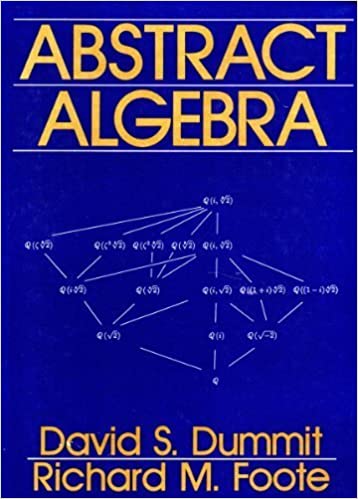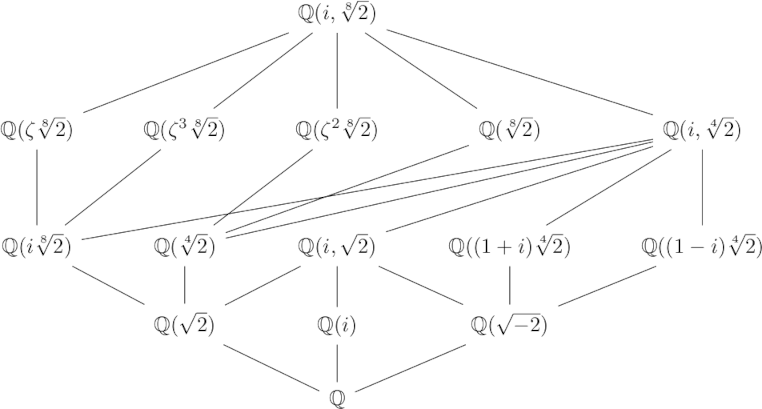The previous post listed three posts I’d written before about images on the covers of math books. This post is about the image on the first edition of Dummit and Foote’s Abstract Algebra.

Here’s a version of the image on the cover I recreated using LaTeX.

The image on the cover appears on page 495 and represents extension fields. If you’re going through this book sequentially as a text book, it’s likely time will run out before you ever find out what the image on the cover means. If you do get to it, you get to it near the end of your course.
My diagram is topologically equivalent to the original. I took the liberty of moving things around a bit to keep the diagram from being awkwardly wide.
At the bottom of the diagram we have ℚ, the field of rational numbers. At the top of the diagram we have ℚ(i, 21/8), the smallest field containing the rational numbers, the imaginary unit i, and the eighth root of 2. Lines between fields on two levels indicate that the higher is an extension of the lower. The constant ζ in the diagram is
ζ = √i = √2(1 + i)/2.
The significance of the diagram is that extension field relationships like these are important in Galois theory. The image appears late in the book because the majority of the book is leading up to Galois theory.

Galois theory was one of my favorites to cover in college — I even took an advanced course meaning we went through Galois Theory at an accelerated rate because I took to an intermediary course in Abstract Algebra quite well. This was a couple years shy of a decade ago, and, coincidentally, I have recently opened up Galois Theory [2nd Ed.] by David Cox to partake in independent study and hit the chapters I never covered before. Galois Theory is incredible in my opinion and the work done by Galois, for his time, seems like pure genius in my own opinion. This post even reminds me of the fun I had working a question from the final exam of the aforementioned college class finding all intermediate fields of Q( sqrt(3 + sqrt(5)) ) and refer to this link if interested where I had even asked for a little help at the time =] — https://math.stackexchange.com/questions/1258582/what-are-all-the-intermediate-fields-of-mathbbq-big-sqrt3-sqrt5-big. I must say great post!
One feature of the original diagram is that the links were all very short. Your new version has some very long links, which is the cost of smaller width. Long lines are harder to synthesize in a whole picture; I find the original picture is much easier to take in all at once. Perhaps there is an even better in-between?